East Meets West Gallery is proud to present “The Endless Road to… Part I”, a group art exhibition dedicated to the VI Moscow Biennale of Contemporary Art which will run from October 8 till November 15, 2015 at The All-Russian Museum of Decorative, Applied and Folk Arts.
The Graphic works by Natalia Zarovnaya and sculptures by Vladimir Peldyakov will be shown at The Carriage Gallery of The Museum.
The second part of the exhibit will be displayed outside in the Museum Park and includes installations and sculptures by Alexey Dyakov, Olga Khan and Andrei Mitenev. Alexey Dyakov will present his new installation “The Limit of Potential” (2015), dedicated especially to the Biennale, and Andrei Mitenev and Olga Khan will show their project “Decomposed Piano” (2013-2015).
Natalia Zarovnaya – is a bright representative of “geometric” abstraction of the late XX – early XXI century. “Staying on the traditional grounds and using the traditional material – etching, Zarovnaya stays solid with the Modernist paradigm by using her traditional sources to promote new radical problems put forward by classical avant-garde movement.” B. Mamonov
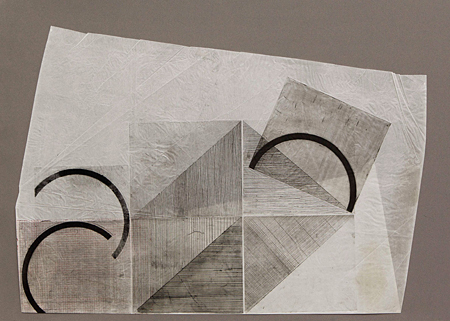
Natalia Zarovnaya. Series of works “Transformers”, Paper №4, 2015. Etching on tracing, 87х63
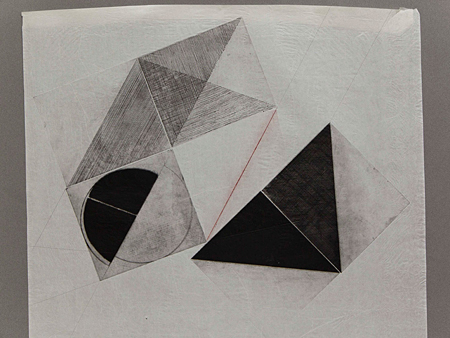
Natalia Zarovnaya. Series of works “Transformers”, Paper №5, 2015. Etching on tracing, 73х87
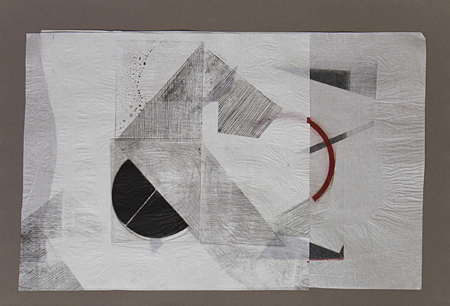
Natalia Zarovnaya. Series of works “Transformers”, Paper №3, 2015. Etching on tracing, 96х625
Her works “Point”, “Terminal. Antwerp”, “New Province” or “The Garages, Depot” are attributed to the subject of Architecture, which the artist has been dealing with for a long time.
But Architecture to her is rather a symbolic sign, “a form of utopian consciousness” than a simple object of Art. Dynamics and rhythm of her works, its plastic structure and composition based on the lattice, allows us to search and find the formal origins of her work in the Russian Constructivism and philosophical ideas of Kazimir Malevich’ Suprematism. By creating signs, images of material life she rises from the material to the spiritual, and up to the higher unconscious. “I understand abstraction as an opportunity to change the focus of view, to get inside the structure of an object or phenomenon.” N. Zarovnaya
This is especially true to her new series of works “TheTransformers”, 2015. Using the philosophy and the technical capabilities of the etching, the artist individualizes each work, working with different types of paper, creating an internal volume of constructions double and triple overlayed sheets, using the mixed technique of etching, the collage, giving every new product its unique stylistic features.
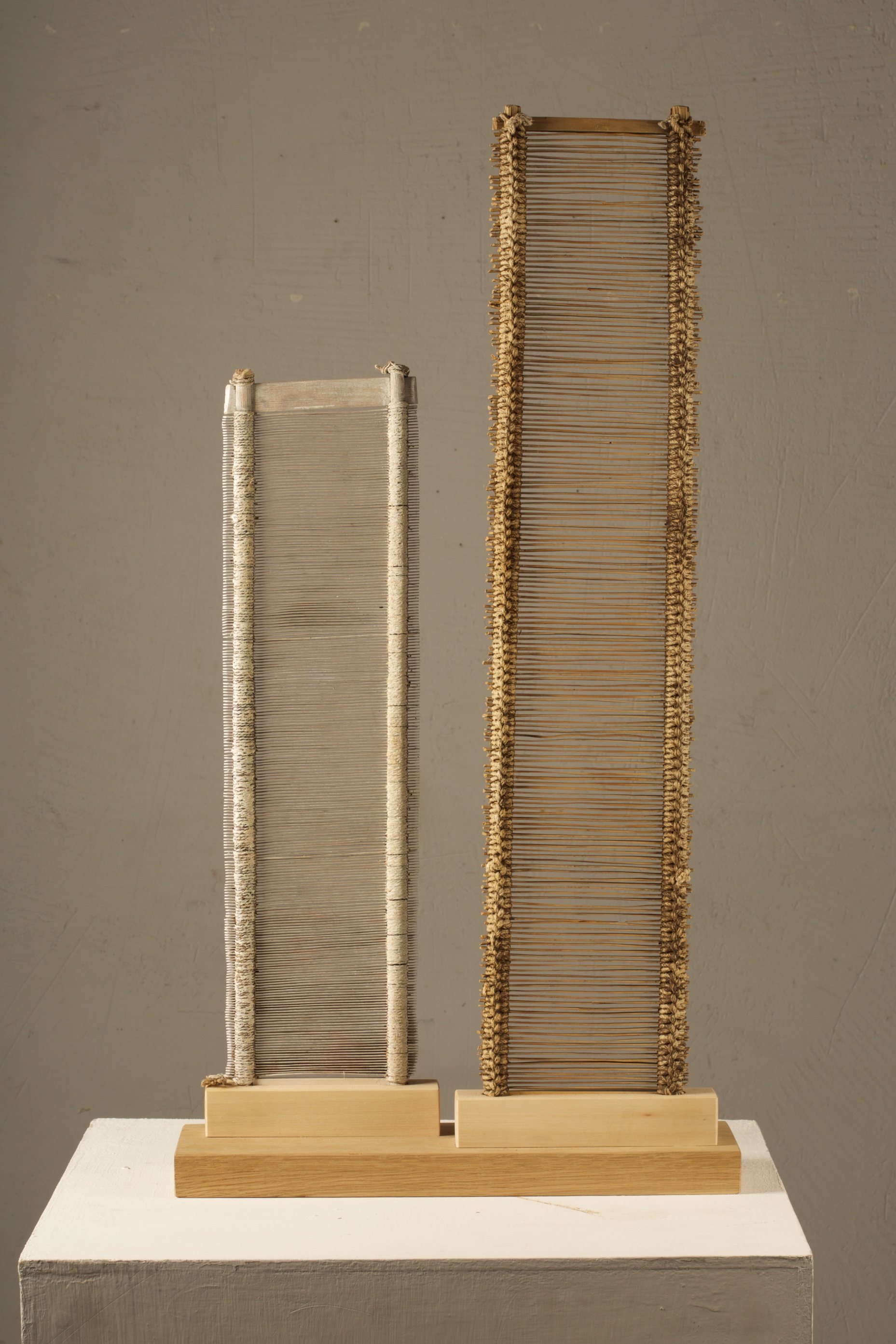
Vladimir Peldyakov. Horizontal Structure, 2014. Wood, rope, metal mesh, 75х50х12

Alexey Dyakov. The Limit of Potential, 2015. Mixed media, wood, acrylic, metal, light, 270х170х100
Vladimir Peldyakov’s works can be regarded more as sketches or small plastic finished models for the future monumental sculptures which are not yet done. The dimensions of works and the simplicity of the materials selected by the author (wood, rope, metal mesh) formalize the process of their creation.
In Alexey Dyakov’s installation “The Limit of Potential” contains three wooden vertical barrels, symbolizing the life of three friends. They try to climb up on the road to excellence and self-expression, but two of them “burn out” before reaching the top. Only one of them, capable of spiritual and physical victory, reaches his dreams and begins to emit light, illuminating the road to those who follow after him.
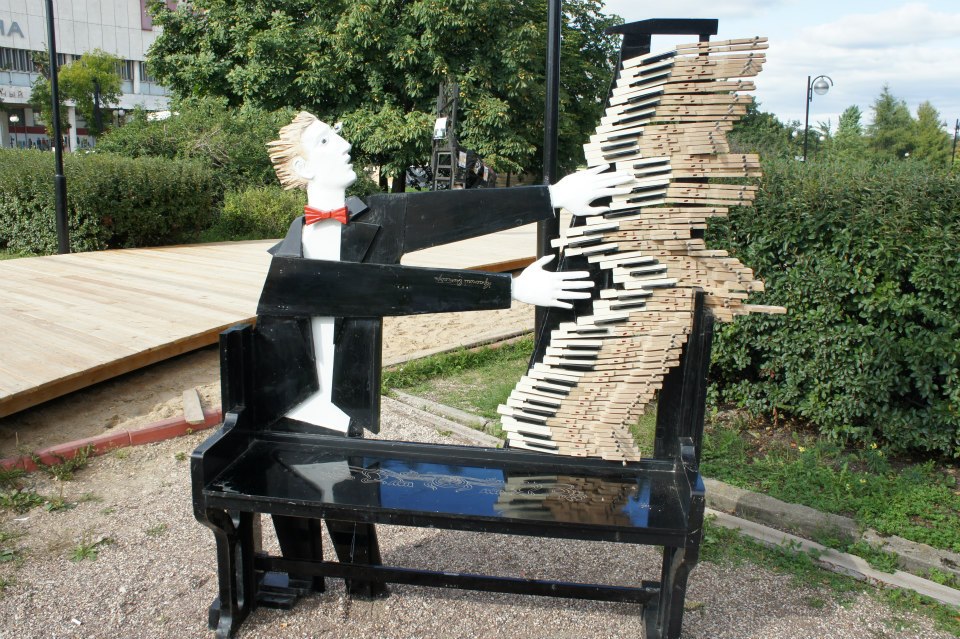
Olga Khan and Andrey Mitenev. Series of works “Decomposed piano”, Piano, 2015. Piano, mixed media, wood, assemblage, 200х160
The idea of Andrei Mitenev and Olga Khan’s project “Decomposed Piano” dates back to 2013 According to the artists, on one hand they had wanted to create a new sculpture from the debris of a piano that had been broken into parts. And on the other, they were also greatly influenced by their passion for experimental new music, especially avant-garde compositions by John Cage and his Russian followers.
The first work in this series “The Piano” is the one that most resembles a sculpture in the traditional meaning of the word. Many contemporary artists at present feel themselves followers to Marcel Duchamp and thus call their works “objects” or installations; they are afraid to call it sculpture, which is nowadays considered to be backward and anachronistic. And the artists would have all rights to consider their piece (reconstructed from dismantled parts of a piano) a direct “heir” of Duchamp’s Dada ideas. But the figure of a pianist intoxicated by music, with his huge symbolic hands extending to the deck, create a solid sculptural composition – a symbol of the unity of a musician with his instrument. Andrei and Olga achieve even more symbolism and abstraction in their joint work “Trio-1” and “Trio 2”. Structural elements in both sculptures are the same as in their first work, but vertical and horizontal architectural factors as well as the color palette clearly reveal the avant-garde legacy of their works.
OPENING PARTY “THE ENDLESS ROAD TO… PART I”
Press release
East Meets West Gallery
“The Endless Road to …. Part I”
The East Meets West Gallery is proud to present “The endless Road to… Part I”, a group art exhibition dedicated to the VI Moscow Biennale of Contemporary Art which will run from October 8 till November 15, 2015 at The All-Russian Museum of Decorative, Applied and Folk Arts.
The Graphic works by Natalia Zarovnaya and sculptures by Vladimir Peldyakov will be shown at The Carriage Gallery of The Museum.
Natalia Zarovnaya – is a bright representative of “geometric” abstraction of the late XX – early XXI century. “Staying on the traditional grounds and using the traditional material – etching, Zarovnaya stays solid with the Modernist paradigm by using her traditional sources to promote new radical problems put forward by classical avant-garde movement.” B. Mamonov
The series of her works “Point”, “Terminal. Antwerp”, “New Province” or “The Garages, Depot” are attributed to the subject of Architecture, which the artist has been dealing with for a long time.
But Architecture to her is rather a symbolic sign, “a form of utopian consciousness” than a simple object of Art. Dynamics and rhythm of her works, its plastic structure and composition based on the lattice, allows us to search and find the formal origins of her work in the Russian Constructivism and philosophical ideas of Kazimir Malevich’ Suprematism. By creating signs, images of material life she rises from the material to the spiritual, and up to the higher unconscious. “I understand abstraction as an opportunity to change the focus of view, to get inside the structure of an object or phenomenon.”
N. Zarovnaya
This is especially true to her new series of works “TheTransformers”, 2015. Using the philosophy and the technical capabilities of the etching, the artist individualizes each work, working with different types of paper, creating an internal volume of constructions double and triple overlayed sheets, using the mixed technique of etching, the collage, giving every new product its unique stylistic features.
“Natalya Zarovnaya – a brilliant master of etching, with all its polysyllabic techniques. For several decades she works at Senezh workshop that once was famous All-Union House of Arts. We’ve have already written about it in our newspaper. During the hard time of mismanagement at Senezh House of Arts Natalia was the sole keeper and protector of The Graphic Lab property and at the same time managed to work actively and take part in multiple exhibitions.” William Meiland
Vladimir Peldyakov’s works can be regarded more as sketches or small plastic finished models for the future monumental sculptures which are not yet done. The dimensions of works and the simplicity of the materials selected by the author (wood, rope, metal mesh) formalize the process of their creation. In two scuptures presented the artist uses different methods of plastic sculpture development dating back to the modernism and Russian avant-garde of the early 20th century. In his work “Horizontal Structure” he refers more to the “geometric” abstract direction, on the contrary the work “Onward” is a more ambiguous work. Its plastic structure reminds a male figure and as a constructor is assembled from rectangular bars, turned to the audience each time by a new facet. A cubistic figure of “Onward” does not seem static, it’s all in motion and directed forward, as if responding to the desire of the artist to break out one style.
The second part of the exhibition will be displayed outside in the Museum Park and includes installations and sculptures by Alexey Dyakov, Olga Khan and Andrei Mitenev. Alexey Dyakov will present his new installation “The Limit of Potential” (2015), dedicated especially to the Biennale, and Andrei Mitenev and Olga Khan will show their project “Decomposed Piano” (2013-2015).
Avant-garde and minimalism, constructivism and kineticism – can they all be combined in one work? And what if the artist then adds symbolism and allegory, which can point either to an antique or a postmodern context? Nothing is impossible for Alexey Dyakov.
His installation “The Limit of Potential” contains three wooden vertical barrels, symbolizing the life of three friends. They try to climb up on the road to excellence and self-expression, but two of them “burn out” before reaching the top. Only one of them, capable of spiritual and physical victory, reaches his dreams and begins to emit light, illuminating the road to those who follow after him.
The idea of Andrei Mitenev and Olga Khan’s project “Decomposed Piano” dates back to 2013 According to the artists, on one hand they had wanted to create a new sculpture from the debris of a piano that had been broken into parts. And on the other, they were also greatly influenced by their passion for experimental new music, especially avant-garde compositions by John Cage and his Russian followers.
The first work in this series “The Piano” is the one that most resembles a sculpture in the traditional meaning of the word. Many contemporary artists at present feel themselves followers to Marcel Duchamp and thus call their works “objects” or installations; they are afraid to call it sculpture, which is nowadays considered to be backward and anachronistic. And the artists would have all rights to consider their piece (reconstructed from dismantled parts of a piano) a direct “heir” of Duchamp’s Dada ideas. But the figure of a pianist intoxicated by music, with his huge symbolic hands extending to the deck, create a solid sculptural composition – a symbol of the unity of a musician with his instrument.
Andrei and Olga achieve even more symbolism and abstraction in their joint work “Trio-1” and “Trio 2”. Structural elements in both sculptures are the same as in their first work, but vertical and horizontal architectural factors as well as the color palette clearly reveal the avant-garde legacy of their works.
The All-Russian Museum of Decorative, Applied and Folk Arts and the East Meets West Gallery are pleased to invite you to a joint opening party of the exhibit “The Endless Road to… Part I” on Thursday, October 8 at 18:00 at the Museum. The exhibit will run from 8 October to 15 November 2015 at the Carriage Hall and the Museum Park
The museum is open daily (except Tuesdays) from 10:00 to 18:00 (21:00 on Thursdays)
Delegatskaya Str., 3
www.vmdpni.ru
+7 (499) 973 32 19
EAST MEETS WEST GALLERY
Director Tatiana Paleeva
Tel.: 8 (916) 680 53 90
E-mail: paleeva@emwgallery.com
www.eastmeetswestgallery.ru

